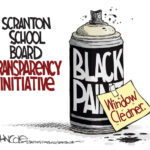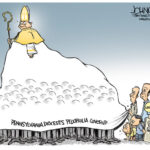“They gave me a standing ovation when I grounded out.” — Yankees shortstop Derek Jeter
 The date: July 6-10 and Aug. 22-24, 2013
The date: July 6-10 and Aug. 22-24, 2013
The place: PNC Field
The situation: Fans look forward to the occasional injury rehab series at minor league parks. Minor league teams look forward to them as well, because they’re good business.
In the summer of 2013, the RailRiders arguably got the best rehab player in baseball history.
Battling an ankle injury that had many wondering whether he’d ever be a great player again, Derek Jeter scratched and clawed his way back to the big leagues. But, that only came after an extended rehab stint with the RailRiders that captivated the entire region for parts of two months and brought sell-out crowds to the newly renovated PNC Field, providing a launching pad for a rebranded franchise that hoped to reconnect with its fan base.
The lead-in: It was the best of seasons and the worst of finishes for Jeter.
The Yankees captain, an all-time legendary shortstop, a transcendent player already ticketed for Cooperstown, Jeter put together arguably the greatest offseason ever for a 38-year-old everyday shortstops in 2012. He hit .316 with 15 homers and 58 RBIs, leading the American League with 216 hits. He helped the Yankees get to the playoffs, and he hit .364 in a five-game Division Series triumph over the Orioles.
The Captain and the Yankees went to the American League Championship Series as favorites against Detroit, looking for their 28th world championship. But in Game 1, while diving for a groundball up the middle, a bone in his ankle snapped.
For one of the great postseason players in baseball history, it would be the end of playoff performances. The Yankees played the next three games without Jeter, got swept and turned their eyes toward spring training, with the insistence that Jeter would be back, healthy and ready.
He wasn’t.
Noticeably hobbled when he reported to Tampa for spring training, Jeter actually played one game with the RailRiders on March 23, trying to get ready for opening day. But during his rehab, Jeter reinjured the ankle, suffering a similar crack in his ankle near the old one. He’d start 2013 exactly where he ended it: On the disabled list.
For three months, he worked toward his return.
And for three months, he had to overcome setbacks.
By early July, word began to spread that Jeter would be able to embark on a rehab assignment, and in Moosic, hope swelled that he’d get a game or two in at PNC Field.
Little did they know, he’d become somewhat of a fixture.

DEREK JETER takes one of his patented inside-out swings in his first game with the RailRiders. ASSOCIATED PRESS PHOTO
The moment: On Saturday, July 6, the RailRiders were expecting a nice crowd anyway. Once word began to spread the day before on Twitter that Jeter was ticketed to play in the game, it became the hottest ticket in town.
“It’s about as good as it gets,” then-RailRiders general manager Rob Crain said. “We can’t wait to welcome Derek into his RailRiders pinstripes for the first time ever. It’s going to be crazy.”
“I wasn’t going to come until I heard Jeter was here,” added Eric Gatto, 17, of Moscow. “I’m not even a Yankees fan, but I had to see this.”
Jeter’s first game came and went like most rehab assignments do. He drew a crowd. He got wildly cheered. And the game advanced like most games do. He went 0 for 2 at the plate, drew a walk and cleanly fielded the only ground ball hit to him at shortstop.
Ho hum.
“It was fun,” Jeter smiled afterward, “but I didn’t do much.”
His second game went considerably better. On July 7 against Lehigh Valley, Jeter went 1 for 2, worked two walks and went from first to third on a single, showing his ankle was feeling good.
“It’s better getting a hit than getting out,” he shrugged. “I’m sure if I didn’t get a hit, they’d start that whole ‘He hasn’t gotten a hit yet’ thing. It was good. But as long as I’m seeing the ball, then it’s positive. The results, I don’t know if that’s important right now.”
There were some big differences forming between this rehab appearance and typical ones at this point, though. First, media members representing outlets from throughout New York City began jamming into PNC Field’s newer, tinier press box. Second, Jeter’s stay kept getting longer.
And as it did, he nearly became part of the community’s fabric.
Fans started gathering outside the Hilton Scranton and Conference Center, hoping to get a glimpse of him, to wish him luck on his rehab, maybe ask for an autograph as he left his hotel room. Others were able to unwittingly run into him as they grabbed their morning coffee, or a late dinner at some of the area’s better restaurants.
The Starbucks at the Mall at Steamtown became his morning coffee haunt. He had lunch at Osaka on Adams Avenue. At the Backyard Alehouse just around the corner, he was spotted hanging out, having drinks with a few friends.
Wherever he went, fans flocked. It was difficult for businesses he frequented to maintain his privacy, but not for him to keep his good humor when fans came by to wish him well. They did so when he was trying to eat a bacon slab appetizer at Carl Von Luger’s downtown. They tried to maintain a respectful distance as he dined at the State Street Grill in Clarks Summit, or the Downtown Deli on Spruce Street in Scranton. But photos from fans who saw Jeter in line for coffee, driving by on the way to the ballpark, or standing outside the hotel went viral around Scranton during his stay.
“As a baseball fan, it doesn’t get any better than Derek Jeter,” said 23-year-old Mark Grambo, an Atlanta Braves fan. “It doesn’t matter who you like, it was awesome. He’s the face of the game, a non-steroid using hero.”
““Everyone has been great,” Jeter added. “I’ve run into a lot of Yankee fans, which is always good.”
Amidst all the hooplah, Jeter continued to play solid ball and feel strong. He went 0 for 2 but played a clean shortstop on July 8 against Rochester. He made a throwing error and went 0 for 3 two nights later, but there were no issues with the ankle. Which was a good thing, because the Yankees activated him from the disabled list and called him up after the game.
“I felt good,” Jeter said. “There were a lot of different situations that happened. … A couple different types of plays.”
The Captain played in one game for New York, then went back on the disabled list with a quadriceps strain.

Wherever Derek Jeter went in Scranton, a growing press contingent was sure to follow. ASSOCIATED PRESS PHOTO
The injury bug got as close to him as the fans in Scranton seemed to; but this time, Jeter seemed to mind.
Jeter returned from the quad strain on July 28 without a rehab assignment. This time, he appeared in four games before a calf strain forced him back on the shelf.
That time, Jeter needed a few minor league games to work himself back into a rhythm, and of course, he went back to PNC Field.
“It has been a very frustrating year for me,” Jeter said when he returned. “I think I missed more games this season due to injury than I have in my entire career combined. It has been very frustrating. I want to get back as soon as possible, but I understand there’s a process to it.”
For what it was worth, Jeter’s best game with the RailRiders came on Aug. 22, when he went 2 for 3 against Pawtucket — he always did save his best work for the Red Sox — with a double. But he also made an error on a chopper up the middle that led to a pair of Red Sox runs in a 5-2 defeat.
The next night, he played clean defensively, but went 0 for 3 at the plate and admitted the Yankees were likely to slow-play his return. He played on Aug. 24 against Pawtucket, going 1 for 3.
“The other two times I came back, I got hurt after one game, both times,” he shrugged. “I get the fact that I have to play a few games.”
The Yankees called him up the next day, and a rehabber like no other walked away from PNC Field, toward Cooperstown, via the Bronx, forever.
In the seven games he played for the RailRiders, 66,860 fans made their way to the ballpark to watch him play, an average of just 449 fans below PNC Field’s capacity per game.
HISTORY BEHIND THE MOMENT
 In the end, 2013 was a lost season for Jeter. After that two-game rehab stint in August, he played in just 12 games for the Yankees before the ankle gave out again. He wound up hitting just .190 in 17 games in New York, and figured he’d be heading into spring training of 2014 with plenty of questions to answer.
In the end, 2013 was a lost season for Jeter. After that two-game rehab stint in August, he played in just 12 games for the Yankees before the ankle gave out again. He wound up hitting just .190 in 17 games in New York, and figured he’d be heading into spring training of 2014 with plenty of questions to answer.
On Feb. 12, he answered one of them. He announced via a post on his Facebook account that he’d retire after the season.
Of course, nothing he did in 2014 would harm his place in baseball history. But, just in case, Jeter hit .256, knocked in 50 runs and stole 10 bases in 145 mostly healthy games as a 40-year-old. In his final at-bat at Yankee Stadium, he ripped a game-winning single to right field, walking away from the home fans the way he had entertained them for so many years.
Jeter is eligible to be inducted into the National Baseball Hall of Fame in 2020, and frankly, it would be a tremendous upset if he didn’t get into Cooperstown on his first ballot. If he does, and assuming pitchers Roger Clemens and Curt Schilling fall short, he’ll become the first player ever to don a Scranton/Wilkes-Barre uniform who can be called a Hall of Famer.
Only five players all-time have more than his 3,465 hits — Pete Rose, Ty Cobb, Hank Aaron, Stan Musial and Tris Speaker. But, for what it’s worth, he came into 2019 tied for 398th place on the all-time Scranton/Wilkes-Barre hits list. His four tied him with Tyler Houston, Larry Huff, Keith Kimberlin, Adan Millan, Jeff Natale, Jeff Stone and Jerry Valdez.

Donnie Collins has been a member of The Times-Tribune sports staff for nearly 20 years and has been the Penn State football beat writer for Times-Shamrock Newspapers since 2004. The Penn State Football Blog covers Nittany Lions, Big Ten and big-time college football news from Beaver Stadium to the practice field, the bowl game to National Letter of Intent Signing Day. Contact: dcollins@timesshamrock.com; 570-348-9100 x5368; @DonnieCollinsTT


